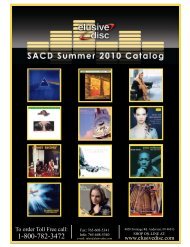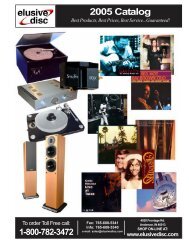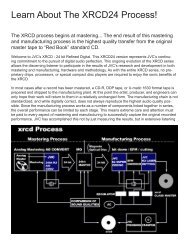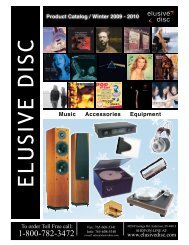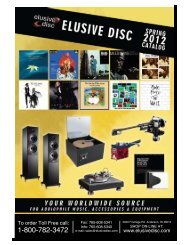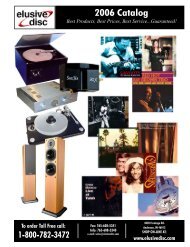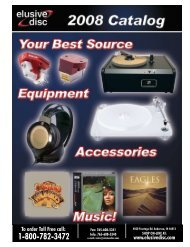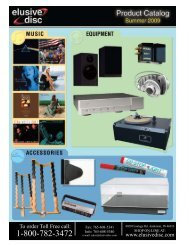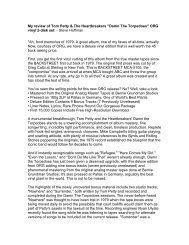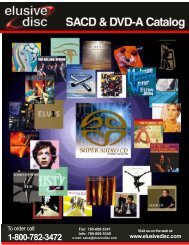SAM'S SPA CE - Elusive Disc
SAM'S SPA CE - Elusive Disc
SAM'S SPA CE - Elusive Disc
- No tags were found...
Create successful ePaper yourself
Turn your PDF publications into a flip-book with our unique Google optimized e-Paper software.
SPM-0408-Sam'sSpace 1/1/04 9:54 AM Page 1S A M ’ S S PA C ESam Te l l i gLong-Lived ProductsIlike long-l i ved pro d u c t s. And longli ved companies. Here ye s t e rd ay,h e re tomorrow. Usually.James E. Sugden foundedRe s e a rch Electronics in the UK in1960 to manufacture scientific inst ruments and audio test gear. A few ye a r sl a t e r, he began producing hi-fi amplifi e r sfor domestic use. In 1969, he intro d u c e dthe Sugden A21 integrated amplifi e r,which delive red a mighty 12 W p c. Pu rec l a s s - A. Speakers tended to be more sensi t i ve back then.J. E. Sugden & Co., Ltd.doesn’t like to discontinuemodels. Th ey letthem evo l ve. The SugdenA 21 A — updated and upratedto 25Wpc, pure class-A — is still available after 35years of continuous produ c t i o n. It may be a re c o rd.The Sugden works arehoused in what looks like anold mill from the start of theindustrial revo l u t i o n, in thesmall West Yo r k s h i re villageof Heckmondwike. Jim Sugdensold the business someyears ago and re t i re d. To nyM i l l e r, who runs the fi r mn ow, said his company continuesto produce “an unhu r r i e d, considered flow ofn ew designs. ”I was unhurried, too. It’s takenme 21 years to rev i ew some pro d u c t sf rom Sugden. That’s because US distributionwas a sometime thing —u n t i lStanalog took ove r. Stanalog is GeorgeS t a nw i c k, who manufacturers and distributesthe Well Te m p e red turn t a b l e sand tonearms. He also imports van denHul cartridges.I wanted to rev i ew the A21a integrateda m p l i fi e r — and may do so soon. 1 N oh u r r y, though. After 35 ye a r s, I don’tthink the product will go out of pro d u c-tion anytime soon. The A21a re t a i l s$ 1595. Add $200 for a mov i n g -m a g-net/coil phono section.Instead of the A21 a, Stanalog sent me1 John Marks wrote about the A21a in his Nove m b e r2003 “Fifth Element” column; see www. s t e re o p h i l e .c o m / t h e fi f t h e l e m e n t /110 3 fi f t h / i n d ex 1. h t m . l — Ed.t h ree models in their Bijou series of minicomponents:the CDMaster CD playe r,which retails for $1995; the HeadMasterline preamp and headphone amp, whichgoes for $995; and the MusicMaster amplifie r, which sells for $1995. Add $495 fora very handsome Bijou equipment rack.That’s $5480 for a thre e -piece systemthat delivers a stated 16Wpc in pure class-A. Of course, in hi-fi, you sometimes getm o re by buying less. But is 16Wpc enoughp ower for most applications? I put thequestion to Sugden’s To nyM i l l e r, who said, more orl e s s, “Not re a l l y. ”“ We do not feel that 15W is suffi c i e n tfor most applications; but 15W into 8 ohmloads with suitable stiffness into lowe ri m p e d a n c e s, with the correct sound stru c-t u re, can give the potential for good musicalperformance.”For those who crave powe r, Sugden’sBijou line offers the AmpMaster stere op ower amplifi e r, which delivers a massive34Wpc for $1095. This little amp is abouthalf the size and price of the MusicMaste r, but it operates in class-A/B, not class-A. The FMMaster stereo tuner will beavailable shortly. (I like this “Master” busine s s. “I want to be a master and not as l ave,” Leporello lamented —my favo r i t eline in Mozart’s Don Giova n n i. )All Bijou components are 9" wide —anice antidote to ove r b u i l t, ove r p r i c e d,oversized hi-fi pro d u c t s. The styling is . . .we l l, stylish, yet free from gaudy ex c e s s.The casework is made in-house from 1 ⁄ 4" -thick aluminum plates (except for the re a rp a n e l s, which are 1/8" thick). Fro n t, side,and rear panels lock into slots in four tubularcorner posts, whose retaining nuts arec ove red by ru b b e r -cushioned aluminumf e e t. All panels are chemically dyed in Sugden’s“black chrome,” a silkyfinish that seems to changecolor depending on theangle at which light strikesi t. Striking.The CDMaster looks likea two -chassis CD playe r :DAC on bottom, transporton top. The two compartmentsare actually combinedin one chassis. Th eCD mechanism is a PhilipsC DM 12 VA M 1202. Th eDAC is the PhilipsT DA 1549, a hybrid singl e / m u l t i -bit conve r t e r.To ny Miller: “The single bitg i ves benefits in the low -f requency performancewhile the multibit characteristicstake care of thehigher fre q u e n c i e s.“ The DAC output isb u f f e red by a dual bipolarJFET op-amp that combinesaccuracy and low noise with high speedand a high input impedance. The bufferstage imparts gain to the signal re c e i ve df rom the DA C, providing a more ro b u s tsignal to the final output stage.“ We have paid particular attention top ower supply. The CDMaster includessix regulated power supplies, strategicallyplaced to ensure seamless performancef rom the signal path. ”Upsampling? The magic bullet?“ We feel that upsampling is not apanacea to the achievement of good sounds t ru c t u re. Howeve r, upsampling doesi m p rove the performance of some ‘SigmaDelta/multibit’ systems. Our view is thatc a reful design and proper integration of
SPM-0408-Sam'sSpace 1/1/04 9:54 AM Page 2S A M ’ S S PA <strong>CE</strong>the DA C, output stage, and power supplycan achieve superb analog performancewithout additional ext r a p o l a t i o n. ”I wouldn’t be surprised if the Head-Master is the most popular model in theBijou line. And I love the name. I havevisions of predatory schoolmasters floggingand whipping their young charges —something out of Nicholas Nickleby.A kilobuck is not cheap for a headphoneamp — C reek’s new OBH- 21 SEretails for only $450. But the HeadMasteris also a very fine active pre a m p, witha remote volume control (an ALPS pot)and three line-l evel inputs. Two boxesmight substitute for one.“ The HeadMaster was developed initiallyas a headphone amplifi e r,” To nyMiller ex p l a i n e d. “We designed it to bel o a d -tolerant and able to drive a wide varietyof headphones. We achieved our goalwith a single-rail circuit and a cascodeda m p l i fication stage — this to preve n tphase shift — f o l l owed by a high-c u r re n t,h i g h -bias emitter follower stage.“ H aving developed the unit as a headphoneamp, we chose components to extendits performance as a standalonep re a m p. The challenge was to achieve anatural top end in free air, yet not be intrusi ve through headphones. The HeadMasteremploys only discrete components ofexceptional quality and close tolerance,”To ny added.“And the MusicMaster?”“ The MusicMaster is a phenomeno n,” Miller enthused. “It culminatesC ON TA CTSC REEK AUDIO LT D ., 12 Av e b u r yC o u rt, Mark Road, Hemel HempsteadHP2 7TA, England. Tel: (44)( 0 ) 14 4 2 - 26 0146. Fax: (44) (0)14 4 2 -24 3766. We b :w w w. c r e e k a u d i o . c o m .MUSIC HALL, 108 Station Road,Great Neck, NY 110 23. Tel: (516 )4 87- 3663. Fax: (516) 773 - 38 91 .Web: www. m u s i c h a l l a u d i o . c o m .STA N A LOG, IN C ., P.O. Box 671 ,Hagaman, NY 12086. Tel: (518 )8 4 3 - 3070. Web: www. s t a n a l o g . c o m .J. E. SUGDEN & CO. LT D ., Va l l e yWorks, Station Lane, Heckmondwike,West Yorkshire WF16 0NF,England. Tel: (44) (0)19 24 - 4 0 4 0 8 8 ,(44) (0)19 24-404089. Fax: (44)( 0 ) 19 24 - 410069. Web: www. s u gd e n a u d i o . c o m .m a ny years of Sugden product deve l o p-ment in true class-A amplifi c a t i o n. Th eoutput configuration is fully biased —a l w ays on — and it operates as a singleen d e d, dire c t -coupled output stage.We employ current feedback to maximizethe slew rate and extend the frequencyre s p o n s e . ”And the output transistors?“ T wo NPN bipolar devices perc h a n n e l. ”Does this mean the amplifier is singleen d e d ?THE CDM A STER HAS A DIST INCT I V ECH A RA CTER — A LO VELY LIQUIDI TY, A GENEROUS,FUL L - BODIED WAY WI TH HARMONICS, AS W EET MIDRA NGE, EXTENDED HIGHS .“ The output stage consists of a singles i g n a l -amplifying device, with the backupof a current source. So, ye s, it is a singleendedamplifi e r. ”To ny refers to the “sound stru c t u re” ofSugden pro d u c t s, and I find this mosta p p ropriate. I may have found the Englishequivalent to the French hi-fi term l ar estitution sonore. To ny and the French hifiscribes appear to be talking about thesame thing.“ The input and voltage amplifi c a t i o nstages employ classical current mirro r sand cascoded circuitry to yield maximumbandwidth and minimum phases h i f t,” To ny continued. “The circ u i t r yoperates without any frequency compensationand bandwidth is limited onlyby an input fi l t e r, which has been tuneda c c o rding to Sugden’s sound-s t ru c t u rep re f e rence. The amplifier’s bias has beenset to maximize the output into 4-o h ms p e a k e r s. This makes the amplifier ve r ystable and quite capable with a varietyof speaker impedances. ”Ye s, To ny, but it’s only 15 W.“Like all Sugden amplifi e r s, theMusicMaster belies its power rating,in part because of its total sound stru c-t u re. Also because of its benign distortioncharacteristics. The distortionis mainly second harmonic and almostp u re sinew ave . ”I used the Bijou system mainly witht wo of my re f e rence loudspeakers: theOpera Callas and the Harbeth Compact7. I also tried the system with my re f e r-ence Quad ESL-988 electrostatic loudsp e a k e r s, which clearly re q u i red a morep owerful amp. The Triangle Titus minim o n i t o r s, which re q u i re very little powe r,sounded fantastic.Let’s follow the signal path, startingwith the CDM a s t e r.Th e re are many fi n e -sounding CDp l ayers available today, and some of them,like the Creek CD50 Mk.2 (see below ) ,sell for less than $2000. But the CDM a s-ter has a distinctive character — a l ove l yl i q u i d i t y, a genero u s, full-b o d i e d w aywith harmonics, a sweet midrange,extended highs. It was wonderful withvo c a l s, solo piano re c o rd i n g s, and chambermusic. If yo u ’ re looking for a CDp l ayer that doesn’t sound harsh, bright,and harmonically thre a d b a re, theC DMaster might be your ticket.For some of my listening, I switchedoff the MusicMaster amp and used theC DMaster into the HeadMaster with mySennheiser HD600 headphones. Do yo u rSennheiser ’phones sometimes sound justa little too thin, too delicate — not as richand full-bodied as a pair of Grado RS- 1 s ?The HeadMaster might be the ideal compl e m e n t. And don’t forget: it’s an ex c e l-lent line-stage pre a m p, too, with re m o t evolume contro l — meeting a need oncefilled by the Melos SH A - 1. As beautifullymade as the rest of the Bijou line, theHeadMaster looks as if it might last 20years or more. And there’s that Sugden“sound stru c t u re’’: harmonic richness.To ny Miller is right about the Music-Master class-A amplifi e r — it’s a “pheno m e n o n.” I’m not sure I’ve heard anamp quite like it since the Musical FidelityA1 amplifier of 20 years ago. That was2 0 W — said to be class-A, but in re a l i t ythe amplifier slid into class-A/B at higherlistening leve l s.The Music Master is “100% class-Awithout slipping into B,” according toSugden’s To ny Miller. Like all class-Aa m p l i fi e r s, the MusicMaster runs morethan warm: it runs hot. The output dev i c e sa re conducting all the time, irre s p e c t i veof the signal, with energy not re q u i red forthe load dissipated as heat. Like any class-A amp, the MusicMaster will actually ru ncooler when it’s playing music. It’s alway so n. Like Fre m e r. You’ll want to keep theamp turned off when yo u ’ re not listen-
SPM-0408-Sam'sSpace 1/1/04 9:54 AM Page 3S A M ’ S S PA <strong>CE</strong>i n g. A half hour or so of warmup (and Ido mean warmup) seems to suffice. Wh e nthe amp is nice and toasty, you can hit Play.“ The inefficiency of operation rules outclass-A in all but a few power amplifi e r s, ”Miller declare d. “This gross ineffi c i e n c yis not a concern, though, in low -p owe rd evices such as pre a m p l i fi e r s, headphonea m p l i fi e r s, or the early stages of a powe ra m p l i fi e r, where class-A’s pre d o m i n a n t l ylinear behavior and absence of cro s s ove rdistortion are of particular benefi t. ”When it comes to sound quality, class-A ru l e s. The MusicMaster got me ve r yclose to the sound of tubes —and singleendedtriode tubes at that. I did not hearthe same startling sense of immediacy, thesame “alive” quality that I hear with a goodSET tube amp, such as my re f e rence SunAudio SV-2A3. But I did hear a ve r ysmooth sound, rich harmonics, and as weetly extended top end. As ex p e c t e d,the MusicMaster did not deliver the tightes t, most extended bass.I was surprisedthat the Music-Master did as we l las it did with theOpera Callas andHarbeth Compact7 loudspeakers. Butthe amp ran out of powe rduring difficult passages —solo piano re c o rdings and largescaleorchestral pieces. The clippingwas soft, its onset noticeable as congesti o n, loss of bass contro l, and then audibledistortion.I know — you’d rather have an ampthat doesn’t clip. But let’s say the amp clipsonly 1–2% of the time and then onlyb r i e f l y, with little audible distortion. Duringthe other 98–99% of the time, yo u ’ ree n j oying the benefits of pure class-A operat i o n, the sheer beauty of the sound, themagic of the moment.The MusicMaster is a niche pro d u c tand not suitable for all or even most applica t i o n s. But if you think it might work foryo u, you should give it a listen. You mighttry matching it with a pair of higher-s e n-sitivity speakers, such as most modelsf rom Triangle or JMlab. It might be interes t i n g, too, to hear the MusicMaster witha pair of horn speakers. Even with less sensi t i ve speakers, the Bijou system mightwork well in a small ro o m —an office, forinstance, or a small den.M e a nwhile, the CDMaster and especiallythe HeadMaster could find theirw ays into many more systems. I was sotaken with the HeadMaster that I carriedthe unit into our living room to use it asa preamp to drive the Cary CAS- 8 0 5 CA n n i versary Edition mono power amps.The HeadMaster has a smooth, silky topend that mated particularly well with theC a r y s. True, the HeadMaster offers onlyt h ree line-l evel inputs. But the sound wass u p e r b — tubelike, with no solid-s t a t eh a rdness or harshness. I loved it. I canimagine using it to take the edge off anotherwise bright- or thin-sounding syste m. And with headphones, this may bejust the thing to reduce listening fatigue.Creek CD50 Mk.2 CD play e rH a rd to believe, but Creek Audio Limitedhas been in business for more than 20ye a r s. Like Sugden, the company is know nfor producing cost-e f f e c t i ve products withvery high-quality sound.I ’ ve known the company and itsf o u n d e r, Mike Cre e k, from the beginni n g. Indeed, I first metMike beforeRoy Hall, akaMusic Hall, becameC reek’s US importer. Being a Scotf rom Glasgow, Roy is very good withthe blather — almost as talented as anI r i s h m a n. Ac c o rding to Roy, Creek modelsoften outperform products that costs everal times more. Roy regularly prove shis point at Consumer Electronics Show sand our own Home Entertainments h ows by playing real music — no audiophiledrive l — on his systems.Rumor has it that Creek may intro d u c ea range of higher-priced models later thisye a r, perhaps in time for HE2004 We s t,in San Francisco. Current models wo u l dremain in the line.“ H ow will you sell Creek if the compa ny moves upmarket?” I asked Roy, ashe opened another bottle of rare singlemaltscotch at HE2004 East. “Years ago,you once told me that you couldn’t sellex p e n s i ve equipment with a straight face.”“I’ll bullshit,” Roy re p l i e d, with anythingbut a straight face. “But I’m sure thatw h a t ever Mike makes will offer ve r ygood value for money. One reason thatMike’s designs sound so good is that helistens to every critical part —every re s i s-t o r, every capacitor, every volume pot. ”The CD50 Mk.2, one of Creek’s 50-series components, retails for $1495. It canbe matched with the A50iR integratedamp (50Wpc, remote volume contro l) for$995, or the S50SE re m o t e -c o n t ro l l e dintegrated ($1495). Plug-in MM and MCphono boards are available. Like otherC reek pro d u c t s, the CD50 Mk.2 lookshumble. Its dimensions are small: 17" wideby 2.5" high by 9" deep. The player we i g h s11 lbs. But the sound of the CD50 Mk. 2is anything but lightweight or small. Cre e kp roducts are built for sound, not for show.C reek has always been k n own for itsp roducts’ sonic s i g n a t u re: fast, tight,r hy t h m i c, and punchy. As the companyg rew and as Mike mellowe d, perhaps, hisp roducts retained these qualities whilebecoming more open, delicate, and transpa re n t, more able to deal with musicalc o m p l ex i t i e s. This is what’s on offer fro mthe CD50 Mk. 2 .The player uses a CD-R OMd r i ve. Earlier Creek playe r shad problems playing somec o p y -p rotected discs. Th eCD50 Mk.2 is said to ex h i b i tno such pro b l e m s. I ow njust one disc that I knowto be copy-p ro t e c t e d, andthe CD50 Mk.2 played itwithout a glitch.The goal, as Mike Creek ex p l a i n e d, isto enable the player to work with a virtuallyjitter-f ree signal source. “To conve r tthe signal into a usable format, the playe ruses a digital buffer circ u i t, or FPG A. Th i ss t o res the signal for a short time and convertsit into a suitable format for feeding tothe Crystal Semiconductor CS4396 24-b i t /192kHz D/A conve r t e r. The disc is notp l aying exactly in real time, but is slightlyd e l ayed through the dynamic buffer. Th i sc reates shock immunity from the playe r.The buffer circuit also converts the signalinto an S/PDIF signal to provide a highqualitydigital out, which is available viaTosLink optical as well as coaxial sockets.“ To make the CD50 Mk.2 future -p ro o f,we offer connection of the player to anR S-232 bus. This will allow remote control and serial connection of the player withthe next generation of Creek equipmentor with proprietary room contro l l e r s. Th i sf e a t u re will be available by plugging thea p p ropriate module into the motherboardand upgrading the software. The bufferand the micro c o n t roller are both programmedby separate EPR OMs that containall the code.”“ This is all I need,” said Roy Hall, ru e-f u l l y. “Audiophiles calling about updates. ”When Mike mentioned the CrystalDA C, I wo n d e red whether the CD50
SPM-0408-Sam'sSpace 1/1/04 9:54 AM Page 4S A M ’ S S PA <strong>CE</strong>M k.2 uses upsampling, the magic bullet.Mike gave me a long answe r. The shorta n s wer is no, it doesn’t —just conve n-tional 8x ove r s a m p l i n g.I ran the Creek CD50 Mk.2 into theSugden HeadMaster, using the Sugdenboth as a line-l evel preamp and as an ampwith my Sennheiser HD600 headphones.C o m p a red to the Sugden CDM a s t e r, theC reek CD50 Mk.2 offered a differe n ts o u n d. I won’t say that the difference insound quality was dramatic; it wasn’t. Ican imagine that some listeners might preferthe Sugden, and that others might givethe nod to the Cre e k. As I have said in thep a s t, hi-fi is about choices.The Sugden CDMaster offered a marginallyricher, fuller sound. Less live l y, perha p s, and not quite so we l l -d e fined in theb a s s. The Creek gave me marginallyg reater dynamics, tighter bass, and just atad more re s o l u t i o n. I heard a little moret o p -end extension with the Cre e k. Butyou might prefer the Sugden’s greater harmonicrichness. I don’t want to makethings easy for yo u. Listen for yo u r s e l f.While I could easily live with the Cre e kor the Sugden, I think that the Cre e kCD50 Mk.2 is the more universally applicableplaye r. You could probably place itin just about any system —even a ve r y -h i g h -e n d, high-resolution rig —and haveCD playback quality that comes close toas good as digital gets. This is what MikeC reek is especially good at: He may notmake the absolute best equipment av a i l-able, but he comes so close, and at suchreasonable prices, that he makes you questionthe need to pay more .Not so incidentally, the Creek CD50M k.2 made a splendid transport with theMcIntosh MDA 1000 D/A converter($8000) I discussed last month, delive r i n gwhat I thought was an exceptionally cleandigital datastre a m. Would a far more ex p e n-s i ve separate transport have lifted the performanceof the Mac DAC? I didn’t haveone to try, but I didn’t feel that the MacDAC was being let down by the Cre e k.I did prefer the sound of the Creek intothe Mac DAC to the sound of the Cre e kused alone. With the Mac DAC I heardeven greater re s o l u t i o n, improved dynamic s, and a rare, analoglike sense of ease.(Come to think of it, I heard a similarlyanalog sense of ease with the SugdenC DM a s t e r, but not the awesome re s o l u-t i o n.) But the Mac DAC costs more thanfi ve times as much as the Cre e k.In any eve n t, like the Mac DA C, theC reek CD50 Mk.2 makes me even moreskeptical about the purported advantagesof SACD, especially for two -c h a n n e le n t h u s i a s t s. I know that there we re thoseat HE2004 East who we re saying thatmultichannel is the pre s e n t, never mindthe future, and that two -channel systemsa re obsolete. Antiques. I wonder howm a ny surround speakers will be enough.F i ve? Seven? Nine, anyone? A speaker inthe ceiling? A subwoofer under every ass?S u r round sound for music strikes me asdomestically intru s i ve, uncivilized, andg rotesque. I once had a surround systemfor music and was very happy on the day,22 years ago, when I dismantled it.In a way, it’s good that the big massmarketcompanies have largely lost interestin two -channel: their abandonment ofserious music re p roduction helps ensurethat firms such as Sugden and Creek willh ave a nice niche to fi l l.As far as SACD and DV D- Audio arec o n c e rn e d, people are “staying aw ay ind rove s,” as Samuel Goldwyn once said.Could their lack of enthusiasm be due, inp a r t, to a lack of interest in surround soundfor music?I’m beginning to think that the futureof two -channel looks fairly bright. ■■



